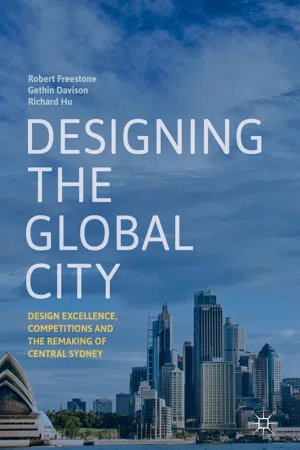The central concern of this book is the pursuit of design excellence and global competitiveness through the mandating of design competitions for large-scale private property developments in central Sydney, Australia. Sydney turns out to be a unique setting because in no other major global city are competitions for private buildings required through statutory city planning processes. The fact that these arrangements have been a conspicuous part of a formal development approval system in place since 2000, with remarkably little public criticism or industry objection, constitutes an outstanding multi-project environment for assessing the procedures and outcomes of competitive design. As interesting as our intensive study may be in its own right, situating it within several broader contexts underpins its wider significance and contribution.
Globalisation, Competitiveness and Design Excellence
High-quality design is now widely regarded as a key contributor to the competitive advantage of global cities. From the last quarter of the twentieth century, different cities responded in various ways to the challenges and opportunities presented by globalisation, but with familiar themes in many jurisdictions centred on urban renewal, sustainability, infrastructure provision, placemaking, urban design, the public realm and cutting red tape in planning processes. There has been increasing recognition of the value of design in the process of urban redevelopment. Today, well-designed urban spaces are considered a prerequisite for sound economic revitalisation (Gospodini 2001). The logic is that high-quality design creates places where people desire to live and work, places where businesses desire to operate and places where economic and cultural innovation incubates. It can also strengthen civic pride and identity and provide a sense of satisfaction for residents (Boland 2017). Well-designed buildings situated within a quality urban environment can improve a city’s identity and image to attract global investment, as architecture becomes encoded as a symbol for global standing. However, despite growing recognition from policy makers of the contribution that good design can make towards a city’s competitiveness, liveability and sustainability, not all new commercial property development is of high quality and contributes positively to the public realm. In addition, a legacy of old and inferior structures constitutes ever-present challenges for renewal and adaptation as community expectations shift inexorably upwards.
The quest for quality is more than a surface aesthetic but relates to a building’s comprehensive performance in complementary financial and public interest ways. This new mantra goes by different names but is well captured by the phrase ‘design excellence’. In architectural, landscape and urban design contexts, this became established as a guiding philosophy in Europe and North America from the early 1980s (Mayors Institute 2002). By the late 1980s and early 1990s, design excellence provisions were finding their way under different nomenclature into various city policy documents (Punter 1999a). The discourse of design excellence was a prominent feature of the British Urban Renaissance (Punter 2009, 2011a) and has since become a recurrent theme in public policy and awards programs in cities across the USA, Canada and Australia, as well as in Singapore and New Zealand.
Excellence is a superlative that refers to a state of a person or thing having qualities, skills or merits that are superior or preeminent in some way. In the context of private property development, the central concern in this book, the relational nature of ‘design excellence’ means that it cannot be defined or drawn in the abstract: it only becomes meaningful and useful through the specifics of individual development sites and projects. Notwithstanding these definitional difficulties, it is safe to say that the attainment of design excellence in any given development will involve the successful marrying of public, private and professional interests. James Franklin (1989, p. 4), drawing on earlier work by Dana Cuff (see Cuff 1991), goes further. He defined design excellence (in architectural terms) as a project-specific quality connecting ‘the perceived quality of the experiences a building or place provides’ for three main stakeholder groups: the participants (clients , designers, consultants), the public (the state, user groups and tenants) and the profession (progressive elevation of design standards and recognition) (Fig. 1.1). In private development, the proponents are intent on maximising returns on investment. The public sector seeks outcomes which address and enhance the interest of the broader community. The design professions welcome recognition of innovation and uplift in quality. Put another way, the ‘keys to design excellence … involve the client, the architect and the other professionals who help to complete a project, as well as the general public who view and use a building or place over time’ (Brewer 1989). While more specifics could be built into this early formulation in terms of sustainability, energy efficiency, indoor air quality, natural light, heritage conservation, public spaces, community amenities, configurations to enhance performance and productivity, and ...
